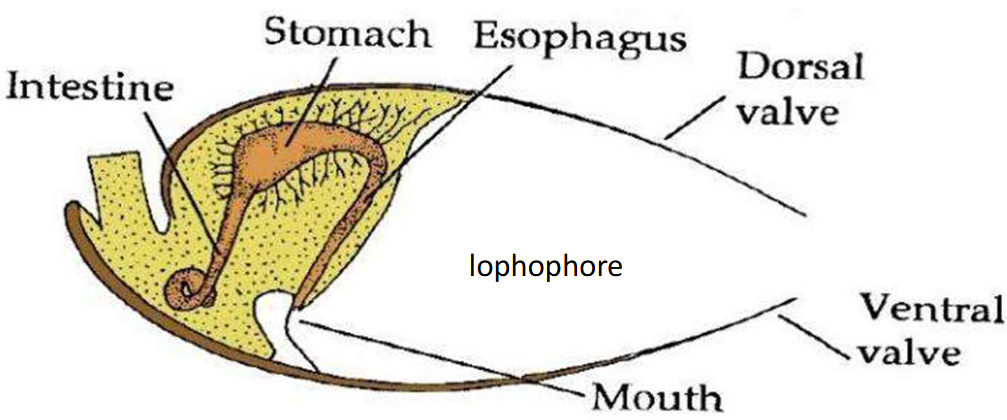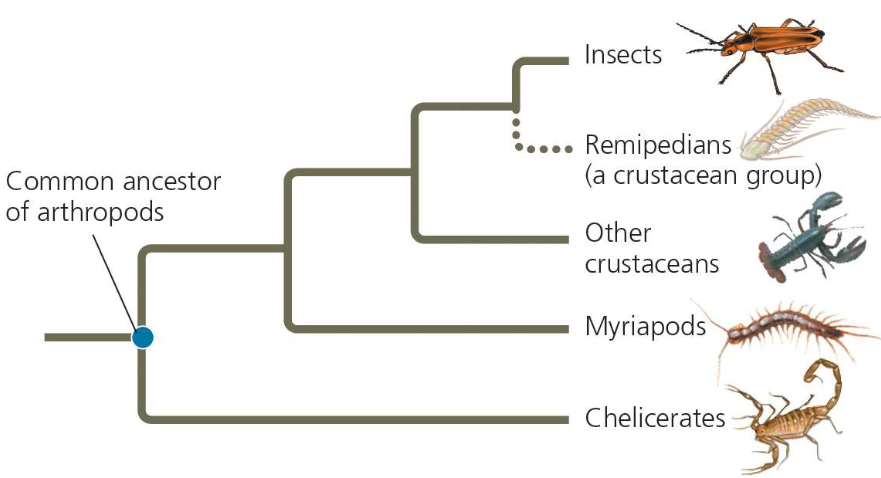Animal Diversity II - Lecture 3
1/84
There's no tags or description
Looks like no tags are added yet.
Name | Mastery | Learn | Test | Matching | Spaced |
|---|
No study sessions yet.
85 Terms
First Split in Animal Evolution History
Tissues vs. Non-Tissues
Porifera: no tissues
Cnidarians and the rest: tissues
Bilateral Symmetry
Symmetry where you can only make one cut and have equal sides, including:
Dorsal-Ventral (top-bottom)
Anterior-Posterior)
Cephalization
The development of much sensory equipment concentrated in the anterior head (head development)
Cephalization of Radial Symmetry vs. Bilateral Symmetry
Radial: Nerves are scattered everywhere (sessile or weakly swimming)
Bilateral: clusters of neurons concentrated in certain regions, formation of head (ganglia / brains) (active movement)
Gut evolution: Bilaterial vs. Cnidarians
Cnidarians: gastrovascular cavity, only one hole for the mouth and one for the anus
Complete gut: Derived character of the rest of the animals
Difference in Blastospore fate in Protostomes and Deuterostomes
Protostomes: The mouth develops first, the anus may form later (ex: Snails)
Deuterostomes: The anus develops first, then the mouth forms later (ex: Chordates)
3 Clades of Bilateria
Deuterostomia
Lophotrochozoa
Ecdysozoa
3 Clades of Deuterostomia
Hemichordata
Echinodermata
Chordata
Hemichord, Chord, Echinoderm
Echinodermata Structure (Starfish)
Water vascular System + Ampulla (movement)
Tube Feet → locomotion/sensing
Echinoderm Symmetry throughout the life cycle
Larva: bilateral symmetry
Adult: Pentaradial symmetry (starfish!)
3 Clades of Echinodermata
Asteroidea
Echinoidea
Holothuroidea
Aster, Echin, Holothur + Oidea >:)
Exemplify how Segmentation is from Covergent evolution
3 Major Phyla, not very related have them:
Annelida, Arthropoda, Chordata
3 Clades of Chordata
Cephalochordata
Urchochordata
Vertebrata
Cephelo, Uro, Vertebrates >:)
Notochord
Cartilage Structure of Chordates:
Structural Support and strength
Dorsal Hollow Nerve Cord
A development of the central nervous system that will grow to the spinal cord
sits atop the notochord
Muscular Segementation
A trait of Chordata, seen in us humans and fish
Pharyngeal Gills/Slits
A characteristic of chordates that:
Allow for movement for water
Suspension feeding
Post-Anal Tail
A feature among Chordates that can be reduced during embryotic development (ex: Humans)
Contains skeletal elements and muscles
Cephalochordata Structure (Lancelets)
Keeps the essential features of a chordate through its whole life cycle:
dorsal hollow nerve cord
notochord
Pharyngeal slits
muscle segmentation
post-anal tail
The most basal group of all the chordates
Urochordata Structure (Tunicates)
Larva: have chordate characteristics:
Notochord
Dorsal hollow nerve cord
Muscle Segmentation
Pharyngeal slits
Post-anal tail
Adult (metamorphosis): Lose them (except pharyngeal slits)
Urochordata Feeding Mechanism
Captures food through cilia, letting in water + the nutrients it may carry
Lets out food through an excurrent siphon
Vertebrate Diversity vs. Animal Diversity
Animals: VERY diverse: many bugs, invertebrates, worms
Vertebrates: small piece of the pie, way less diverse despite our bias to classify them more
Chordata Structure
Vertebrate enclosed spinal cord
Elaborate Skull
(In aquatic Forms) Fin rays
2 Reasons why the Skeletal + Nervous system are evolutionary advantages
Helps with
Capturing Food
Evading Predators
First Organisms to be vertebrates
Hagfish (bottom ocean scavengers)
Lampreys (parasites)
Both with cartilage skulls and jawless mouths
Outlined Jaw Evolution
Jaws grew from the Pharyngeal Slits, moving forward as to modify the facial structure
Gnathostoma
A Clade of Jawed Vertebrates, including:
Sharks
Reptiles and Birds
Mammals (us!) (we are considered jawed fish in this clade)
Osteichthyes/Osteichithyan Clade Structure
Fish that comprise of a skeletal structure, divided into two subcategories
Ray-Finned Fish
Subcategory of Osteichthyes/Osteichithyan Clade
Flexible rays modified for maneuvering + defense
Trout/Salmon/Cod
Lobe-Finned fish
A subcategory of the Osteichthyes/Osteichithyan Clade
Their fins have muscles
From which tetrapods and limbs developed
Tetrapod Structure
Limbs (from fins)
Head separated from the body by a neck
Pelvis bones fused to backbone
Adults, no gills (except Salamanders)
Amphibian Exceptions to the Tetrapod Structure
Salamanders:
Still have gills as adults (some land, some water)
Frogs:
Larva stage still has gills
- Both: External Fertilization
Amniota
All tetrapods, excluding the amphibians
Amnion Derived Character (list all 4 + Functions)
An egg with four membranous sacks
Amnion: Shock absorber
Chorion: Gas exchange
Yolk Sac: Nutrients
Allantois: Waste Storage
Advantages of Amnion egg development
Eggs can be laid
No longer requires water (Amphibian eggs need more concentrated O2 diffusion, best in water)
Mammalia
A clade of animals characterized by their nourishment with milk and hair
3 Clades of Mammalia
Monotremata
Marsupials
Eutherials
Monotremata: How they are Unique Mammals
They still lay eggs
ex: Platypus :D
Marsupial vs. Eutheria Gestation
Gestation: time it takes for organism to develop from an embryo to an adult
Marsupial: VERYYYYY long
Eutherial: Shorter (Humans!)
Lophophore
A feeding structure among lophotrochozoans
Ectoprocta
Brachiopoda
Trochophore Larva
A particular larva form unique to certain lophotrochozoans
Annelids
Characteristics of Lophotrochozoan Ancestor (does not mean all descendants have these)
Coelem
Digestive Track, Two Openings
Mollusca structure
Lophotrochozoan Structure with:
Muscular Foot (movement)
Mantle (cover, shell, water-filled chamber)
Radula
Visceral Mass (internal organs)
Radula
A tongue that takes food off a substrate [covered in microscopic teeth]
4 Clades of Molluska
Gastropods
Bivalves
Polyplacophora
Cephalopoda
Gastropod Structure
Shell is one big piece (snails)
Radula are used to feed on plants and algae
Bivalvia Structure (how it differs from brachiopoda)
Two piece shell (Left and Right shells, opposed to top/bottom shells)
No distinct Head
Sedentary + Suspension Feeders
Polyplacophora structure
Organisms named Chitons have:
Many pieces of shell
Scrapes of algae from rocks
Cephalopoda structure
Tentacles to grasp prey
Lost or very small shell
Cephalopoda Evolutionary Advantages
Intelligence
Camouflage
Highly developed sensory shit
Annelida Structure + Development
Segmentation
Compartmentalized organs
Trochophore Larva Stage and Metamorphisis
2 Clades of Annelida
Errantia
Sedentaria
Errantia Characteristics
Segmentation, like all annelids
Mobile predators / Grazers (Marine)
Appendages, Parapodia Sticking out for locomotion
Sedentaria Characteristics
Move less
Elaborate Gills
Leeches
Sedentary organisms that can be predators, feeding on other vertebrates
Earthworms
Sendetaria that extract nutrients from the soil!
Brachiopoda Structure
Has a lophophore, but no trochophore larvae
Two muscles: one opens, one closes
Brachiopoda Symmetry
Two halves are dorsal and ventral rather than lateral like Bivalves
2 Clades of Brachiopoda
Inarticulata
Articulata
Inarticulata Structure
Small or no hinge (Lingula)
Complete gut: mouth + intestinal track + anus
Articulata Structure + Digestion
large hinge
incomplete gut, no real place for waste → come in through mouth, processed, leaved through mouth
Intestine protrudes out of the back of the shell

Platyhelminthes Structure (Flatworms)
Light-sensative Eye Spots
Gastrovascular Cavity
Acoelomates
Gas Exchange through skin, very close b/c high SA:V
3 Clades of Platyhelminthes
Turbellarian
Trematoda
Cestoda
Neodermata + Subgroup Structure
Clade of Platyhelminthes comprising of the trematodes and cestodes
trematodes: Schistosoma, parasitic worm
Cestodes: tapeworms, no gastrovascular cavity!
Ecdysozoa Unique Structure
Exoskeleton, a cuticle/shell that periodically sheds and reforms (Ecdysis)
2 Phylums of Ecdysozoa
Nematoda
Anthropods
Nematoda Structure (Roundworms)
Psuedocoelomate body structure
Body covered with flexible cuticle + periodic sheds
The MOST COMMON animal on Earth!!
Either parasitic (needs host) or free-living (no need for host)
Important Model Organism in Research + Why: A Nematode
Caeonohabditis Elegans
known genome
Small size
easy to grow
simple body, lots known!
Arthropod Structure
Segmented Body
Hard exoskeleton, completely covered in cuticle
Jointed appendages
Tagmata (segments grouped together)
Open circulatory system
Open vs. Closed Circulatory System
Function of Appendages
walking (legs)
defense (claws, intimidation)
fangs (spiders, inject venom)
sensation (antenna)
3 Clades of Arthropods
Chelicerata
Myriapoda
Pancrustacea
Chelicerata 2 Clades
Eurypterids
Arachnids
Chelicerata Structure
6 pairs of appendages (1 Chelicerae, 1 Pedipalps, 4 pairs of legs)
Sensitive eyes
Open circulatory System
2 Arachnid Tagmata Structure
Posterior Abdomen: Heart/Reproductive Structures/Digestive System/Poison and Silk glands
Cephalothorax
Myriapoda: Centipede vs. Millipede difference
Centi: one pair of legs, carnivorous
Milli: two pairs of legs, herbivorous
Pancrustacea Evolutionary History
Insects are more related to crustaceans than myriapods
Some crustaceans are still excluded, hence the group is paraphyletic

Chelipeds
Claw-like appendages that characterize crustacea (lobsters)
Crustacea Structure
Two segment groupings (tagmata)
Sephalothorax: manner antennae, chelipeds, and walking legs
Abdomen/tail: much muscle
Hexapoda Structure (Anthropod clade)
insects and 6-legged kin
Do complete or incomplete metamorphosis
Lightweight exoskeleton of Chitin
Head - 5 Segments
Thorax - 3 Segments
Abdomen - up to 11 Segments
Incomplete vs. Complete metamorphosis
Complete: Larva to adult
Incomplete: Young nymphs already ressemble adults, true bugs do this
Structure of ALL Insects
3 Body parts
6 Legs
(usually, they have 4 wings and 2 antennae)
How flight Evolved in Insects
Hexopoda clade
Wings were an extension of the exoskeleton and cuticle, NOT APPENDAGES
Evo. adv: escape predators, find food, find new habitats faster
4 Clades of Hexapoda that do Complete Metamorphosis
Beetles
Flies
Wasps and Bees
Moths
2 Claes of Hexapoda that do Incomplete Metamorphosis
True Bugs
Grasshoppers